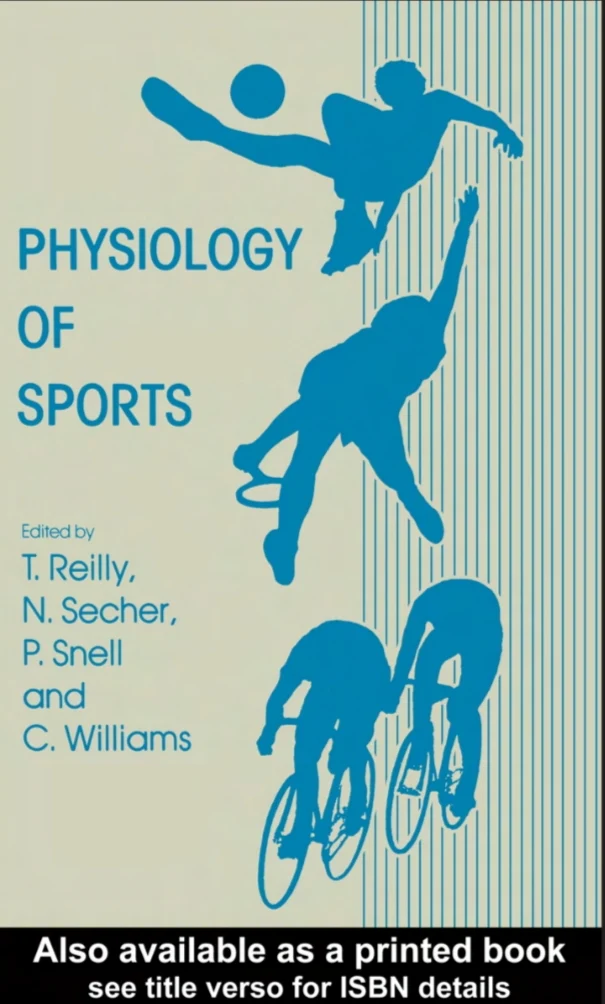Physiology of Sports PDF
In this book an international group of sports scientists examine the major sports and the physiological demands of each.Recent decades have witnessed a remarkable expansion of the applications of scientific principles to sport and exercise.
This has been associated with the emergence of sports science as a recognized academic discipline. Developments are such that most international teams now have a systematized scientific back-up as they prepare for major competitions. Applications of science to sport are especially evident in the field of
physiology; indeed sports practitioners are quick to realize the importance of acquiring basic physiological knowledge that can be put to good effect.
Exercise physiology has for many years been a respected field in its own right.
Exercise has conventionally been used as a medium for perturbing physiological systems to ascertain how they behaved under stress.
Thus much information has been acquired in mainstream human physiology about acute physiological responses to exercise. Exercise physiologists have taken this further in establishing the ceilings in human physiological responses and in attempting to identify those factors that limit performance in various conditions.
There has also been progress in understanding how the upper limits of
physiological function can be pushed further by proper diet and nutritional manipulations.
This information is continually being integrated and updated in textbooks of exercise physiology.
These books have formed basic references not just for students of physiology and sports science but also for sports practitioners eager for literature about the
physiological aspects of exercise and training.
The present text is unique in that it tries to spell out physiological implications for a
number of sports, taken in turn. Thus, far from being another book on exercise
physiology, it fits information about acute and chronic adaptations to exercise to the
peculiarities of each sport.
The individual requirements of each sport are first outlined before the demands of the sport, the fitness profiles of top performers and training regimens are considered.
Part One has two chapters that provide a general physiological background from which the physiology of particular sports may be approached. The principles outlined can be applied broadly to exercise and sports physiology. The opening chapter presents a detailed account of metabolic aspects of exercise.
The other provides an analysis of
muscular adaptations to strength training, a topic of importance to a wide range of sports.
Part Two considers locomotive sports, starting with short-term exercise—in the form of sprinting—and progressing to middle distance running, then to sustained endurance exercise.
This is illustrated in the form of marathon running and competitive race- walking. Both shortterm and endurance exercise apply to cycling and their considerations are integrated in the final chapter of the series of five.
In Part Three the physiology of sport on water and on ice is covered. The requirements of the various swimming events are compared in the opening chapter as is the specificity of exercise in the water.
The sailor has entirely different demands (as has the rower) and hopefully with good craftsmanship stays clear of the water whilst propelling the vessel through it.
The main sports conducted on ice are selected for treatment and discussed in full in the final chapter in this section.
Part Four is concerned with the physiology of games. An attempt is made to group
games with features in common. Thus the various codes of football are examined
together which serves to highlight differences between them as well as the similarities.
The same applies to the racquet sports. The court games of basketball and volleyball are dealt with together in another chapter.
Physiology of Sports applies physiological knowledge to specific sports and represents these applications within a single text. Inevitably not all sports could be accommodated.
Indeed a comprehensive text providing detailed coverage of say all the sports under the Olympic Games umbrella would itself be subject to criticism. Awesome in size, it would still omit major sports not included in the Olympic Games, some of which (for example, Rugby, squash) are in fact covered here. The final chapter is an attempt to present an overall perspective from which some sports not included in the core of the book might be viewed.
The contributors to this text are characterized not only for their scientific aptitudes but also for their practical insights into their specialist sports. This combination allows
interpretations that go beyond those of the sports scientist operating in broad terms. In some chapters expertise is pooled so that the sport in question is treated in a
comprehensive manner.
44444444444
Physiology of Sports is designed for both the academic and the practitioner. Its content is of interest to lecturers and students of physiology, sports science, movement studies, physical education and coaching science. Additionally it will provide an educational
resource for coaches and physical trainers as well as consultants in fitness and
recreational centres that prescribe physical activities and sports for fitness purposes.
It will also be of value to specialists in sports medicine and physical therapy in providing insights into sport-specific physiological stresses.
For this range of readers it will help to the significance of physiology for the sports that are analysed.


Post a Comment